América de Cali
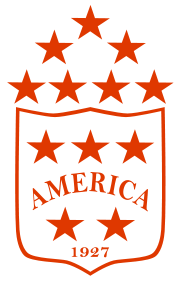 |
||||
| Full name | Corporación Deportiva América | |||
|---|---|---|---|---|
| Nickname(s) | Los diablos rojos (The red devils) Los Escarlatas (The scarlets) La Mechita (The fuse) |
|||
| Founded | December 21, 1918 (as América Football Club) February 13, 1927 (officially) |
|||
| Ground | Estadio Pascual Guerrero Cali, Colombia (Capacity: 45,625) |
|||
| Chairman | ||||
| Manager | ||||
| League | Categoría Primera A | |||
| 2009-II | 17th (eliminated) | |||
|
||||
Corporación Deportiva América, commonly known as América de Cali to distinguish it from other clubs named América, is a Colombian football team, based in Cali. The club was founded in 1927. América is widely recognized as one of the best and traditionally rich clubs in Colombian football. Along with Millionarios, they are the most successful teams in Colombia with 13 national titles.
Contents |
History
The beginning
The team's roots trace all the way back to 1918, when some students from Colegio Santa Librada formed their own team, called "America F.C.", to compete with other schools. The team won the Copa Centenario Batalla de Boyacá in 1919. The team's uniform was light blue with white vertical stripes, light blue shorts, and socks with horizontal stripes in white and light blue.[1][2][3]
The curse of "Garabato"
Benjamin Urrea, better known as "Garabato", was a dentist and one of the most faithful fans of "la mechita".[4] However, he was very strongly opposed to the professionalization of the club and when he learned of this process being carried out by Humberto Salcedo Fernández, he placed a curse on the institution. He is quoted as saying "que lo vuelvan profesional, que hagan con el equipo lo que quieran... que, por mi Dios, América nunca sera campeón", which means that if the team is professionalized, I swear to God that it will never be champion. Although it is said that this curse was broken in 1979 when the team obtained its first national title, there are many people who believe the curse still holds true in the Copa Libertadores since America has reached 4 finals and never been able to win the cup.[5] The popular "Garabato" died on January 5, 2008 in Cali.[6]
The first championships

América got off to a slow start in the Colombian tournament, not achieving even the runner-up position until 1960 and not playing its first Copa Libertadores until 1969. However, the team went through a radical change in 1979, hiring Gabriel Ochoa Uribe as its Coach. During the 12 years Gabriel Ochoa Uribe worked as coach of the team, América obtained its first seven National Cup's and rapidly created an immense diversity of fans that cheered it around the country. During these years, América finished second place in the Copa Libertadores consecutively from 1985-1987.
1979 "Aquel 19" The First Star
Every achievement America de Cali had made throughout its history would be surpassed on December 19, 1979, better known as "Aquel 19" like the popular song by Alberto Beltran. Among these achievements were the 5-0 victory over Deportivo Cali, the undefeated season of 1967, the Second Place finish in 1960 and 1969, and their impressive journey in the 1970 Copa Libertadores. On "Aquel 19" ("That 19"), the entire city of Cali celebrated the team's first national title. Gabriel Ochoa Uribe said, "We are going to be champions. We deserve it. This night we will write history." That night, America de Cali overcame a difficult adversary Union Magdalena, in order to be recognized as the 1979 Colombian Soccer Champion. This unforgettable night, the entire city was painted red with the fans who celebrated until the next day.
1982 A Title in the Cold
After just three years of winning their first title, La Puerca Mecha was heading towards their second one. It was a cold and grey morning that day in Bogotá, where the team faced Millonarios. With noise and an old bus, America de Cali arrived to the stadium Nemesio Camacho (El Campín). Caleños that lived in the city came to support the team as well as many fans arriving from Cali. Millonarios came out with their full attack, but America de Cali played with tranquility and soon enough the first goal came As they kept a close watch on the other games being played that day, America de Cali withstood the constant attack of Millonarios. Time took an important role and as it ran down, it only benefited America de Cali. Deportes Tolima had won their match, Pereira were tying their match, and Nacional had scored their second goal. Everything was going their way and the only thing left to do was win the game against Millonarios. The final minutes were very tense, but once the referee blew the whistle, the fans were able to chant once more, "America Campeon".
1983 Third Star
America de Cali began the season with some changes to create a stronger team for the Copa Libertadores. It included the arrivals of Daniel Teglia, Claudio Casares, Willington Ortiz, Rafael "Vallenato" Agudelo, Henry Alape, Jorge Porras, and Luis Antonio Marcollata. They also brought reinforcement with Brazilians Ademir Praticio and Coccota. With a good participation in the Copa Libertadores El circo de los hermanos Rodriguez Orejuela were eliminated in the semifinal round. Gabriel Ochoa Uribe used his experience to prevent the players from losing their head, in order to accomplish one of the two titles. Willington Ortiz and Juan Manuel Battaglia shone for the team and the dynamic duo combined, scored 40 goals that season. Once the second round began only one team was considered favorite, America de Cali. With the spirit and hard work, America de Cali were back to back champions.
1984 "Champions for a While"
With the same tactics and strength, Las Cabras went for their fourth star. With minor changes in the team, it looked to head for their third consecutive title. Under the management of Gabriel Ochoa Uribe, it seemed that the next star would once again be red. Ochoa, showing the country that he was one of the best coaches at the time, proved it by leading the team to various accomplishments. With the fourth star in his pocket, Ochoa showed that America de Cali was here to stay for good.
1985 Fifth Star; Champions once Again
With a great team and head coach, the "Red Devil" fans felt the star at hand. Everyone remembering their first star just 6 years before. These last few years had been great for the team and its history. With a quick season, America de Cali was awaiting once again the last match to become champions once again. They faced an Junior team, who did not want to get humiliated in their last game. America de Cali came out with everything, putting in two creative midfielders, and . With a quick goal it seemed to be an easy game for the Devils, but Junior pulled together and played it safe, to at least leave with a decent result. America de Cali continued to attack, but the opponent's defense stood well and did not let anything else happen. With a few plays dangerous plays from both sides, in the end, America won with a minimum difference 1-0, obtaining the fifth star for the "Red Devils".
1986 Five consecutive titles
The "Red Devils" made history this year by obtaining five national titles in a row; the highest number of consecutive titles previously was four, by Millonarios. The star was won against their rivals Deportivo Cali, which made the achievement even more special for both the fans and the players.
1990s
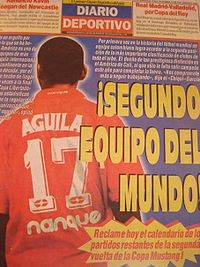
The 1989 tournament was suspended due to the assassination of the referee, Álvaro Ortega. The following year in 1990, America de Cali was once again champion and the following year marked the departure of Gabriel Ochoa Uribe. With his departure, many feared that the winning streak for the "Red Devils" was over. Despite this belief, in 1992, with Francisco Maturana as head coach and Diego Edison Umaña as assistant, América obtained its eighth star and appeared to continue its winning streak from the prior decade. Five years later, America de Cali was able to taste another championship; this was the longest tournament in the history of Colombian Professional Soccer, lasting a year and a half. During this year, America held the first position during the entire tournament and they were crowned champions of the 1996-1997 season after the final match against Atletico Bucaramanga.
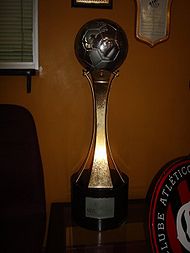
Also in 1996, America was recognized by the IFFHS official world club ranking as the second best team in the world[7], preceded by Juventus of Italy. The team has been ranked 35th in the All-Time Club World Ranking of the IFFHS (International Federation of Football History & Statistics)[8] In 1999, America disputed the national title with Atletico Nacional, in the end losing by way of penalty kicks. After playing two finals in less than three days, America finished the year off with excellent achievements: runner-up of Copa Mustang and winner of the 1999 edition of Copa Merconorte, the team's first international title, against Santa Fe.
The fourth Libertadores final "Garabato strikes again"
- 1996 America de Cali once again reached the final of the Copa Libertadores, again with River Plate. America won the first game in Cali 1-0 with an excellent goal by Antony de Avila from a very closed angle. This was America's chance for revenge after the loss in the 1986 final against the same rival, but in the end America lost famously on an Oscar Córdoba error. The first goal was scored by Hernan Crespo and in an incredible play by Oscar Córdoba, where he left the box and did not clear the ball correctly, Hernan Crespo scored the second goal.
The new millennium and the "Clinton List"
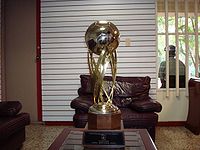
Despite having won the Colombian League three more times from 2000–2002, América has entered the millennium in economic hardship and unable to prove the team that astonished the world in the 1980s. In 1995, Corporación Deportiva América was placed under watch by Executive Order 12978, commonly known in Colombia as the Clinton List. Because of its past connections with drug cartels, the United States froze the team's assets in the U.S. (valued around $1 Million), and ordered other companies not to conduct direct business with América. Also, according to the club's president,
Carlos Puente, the club never received the prize money of $200,000 from the Copa Merconorte championship. Since then, América's economic crisis has been severe. Currently immersed in nearly $2 million dollars worth of debt, América has survived four years without a direct sponsor and only receiving money through minimum attendance at the Pascual Guerrero and the selling of soccer jerseys. The monthly salaries of its players do not exceed $3000 dollars, and América has seen itself forced to make money by selling its most recognized players.
However, despite its troubling economic situation, América has maintained a very respectable level of play and still holds a strong tradition as a historical team, although this is slowly fading too. In 2003, America again faced River Plate in the quarterfinal round of the Copa Libertadores, and got their revenge by winning 4-1 (see video).
After three tournaments without reaching the final round, in 2007 America was finally able to do so with Diego Edinson Umaña as head coach and the assistance of Alex Escobar. The team made an excellent season and was a firm candidate to win the tournament, in the end falling short by only one goal. Despite this, the team was not left empty-handed since they obtained a berth to Copa Sudamericana 2008, after 3 years of not participating in an international event. For the 2008 season, Diego Umaña extended his contract and is currently in the process of preparing the team for both Copa Mustang and Copa Sudamericana. Also America de Cali in 2008 has a chance to get off the hated Clinton List. The club and the Mayor from Cali have been talking it over and they want to help the team. This resulted in an agreement to change the team name, and management,but at the same time Keep all the trophy's they have obtained. In the 2008-II Season America defeated Independiente Medellin 4-1 on aggregate to win its thirteenth title and qualify for the 2009 Copa Libertadores.
Uniform and crest
- Home uniform: Red shirt, shorts, and socks.
- Away uniform: White shirt, shorts, and socks.
- Third unidorm: Black shirt, shorts, and socks.
According to historic versions, America first started out using the colors blue and white, which belonged to Racing Club from Avellaneda; then America switched to red and blue. From 1927 to 1931, it alternated between a red shirt and white shorts to a white shirt and red shorts. An article written in El Gráfico, where the America players were referred to as "red devils", caused a special impression and from that moment the uniform was completely red.[9][10]
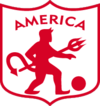
The devil first appeared on the crest in 1940 because of the popular belief that the players "played like devils" on the field. During Gabriel Ochoa Uribe's twelve years with the institution, the devil was always an inconvenience for him so it was removed due to religious reasons. For this reason, the crest only carried the number of stars or titles obtained by the club.
In 1992, the devil was completely removed and was only used for the administrative aspects of the institution. As a celebration of the club's 70 years, the devil was put back on the uniforms. From this date forward, any malignant beliefs regarding the devil have been completely removed. In 2007, in order to conmemorate the club's 80 years of existence, the devil was temporarily replaced with a logo that reads "80 años" (80 years) and underneath "1927-2007"; above the crest are the 13 stars obtained by the club.
Stadium
Rivalries
América de Cali vs Deportivo Cali
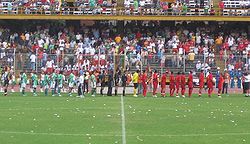
This game is called "el clasico vallecaucano", which translated into English means "the Cauca valley derby." There is a long standing rivalry between these two teams and they have 21 titles combined (one more than Millonarios vs Santa Fe combined), making Cali one of the most important cities in this sport. The first trace of this derby match was in the final of a local tournament in 1931, where América was defeated by The Cali Football Club 0-1; the referee did not count two of América's goals because of supposed offsides plays. Due to the referee's poor performance, América published a series of articles as a protest, leading to the team's suspension from local tournaments for a period of one year.[11] Cali and America have played 262 "clasicos": with 95 wins for Cali, 82 wins for América and 85 draws. In 1969, Deportivo Cali defeated America and won the championship. In 1986, América obtained its fifth consecutive title in the final match against Deportivo Cali and also another title in 1992. This match currently brings 30 to 35 thousand spectators to the stadium.
América de Cali vs Atlético Nacional
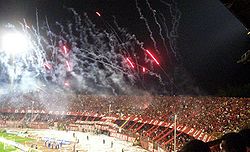
This is one of the most followed games in Fútbol Profesional Colombiano. Since 1979, América and Nacional have seen each other in 15 finals (previously, finals were between more than 2 teams). The most recent final between the two was in 2002, where América was able to defeat Nacional in both matches and as a result obtained the 12th title in its history. Statistics from matches between these two teams show that this is the most even "clasico", with 79 wins for América, 74 for Nacional, and 75 draws. The first time they faced each other in Copa Libertadores was in 1991, and up to this date América has 6 victories, Nacional has 4, and there was one draw.
América de Cali vs Millonarios: The "clásico" with the most stars
These two teams combined have 26 titles and also count with numerous supporter groups known as barras bravas. The rivalry began in the late 70s when América obtained its first title and it grew throughout the 80s, a decade dominated by these two teams. Out of the 10 titles from this decade América won 5 of them and Millonarios won 2. In the 1982 final, América de Cali defeated Millonarios in El Campin, reaching the second title in the club's history. This game was known to paralize the entire country and they fought the 1989 title shoulder to shoulder, until it was cancelled.
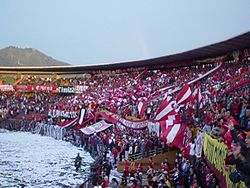
América de Cali vs Santa Fe: the dispute over the color red
This is a much more recent rivalry which does not have an exact date of origin, and it is mostly expressed by Santa Fe's followers. This reaction against the team was originated in the late 80s and early 90s when many of Santa Fe's best players were transferred to América de Cali with little economic compensation, and in the end favored América with obtaining various titles. In the 1999 edition of Copa Merconorte, these two teams faced each other in the final; América lost 2-1 in Cali and then went to Bogotá and won 1-0. The game was decided by penalty shootouts, where América obtained its first international title. On May 11, 2005, in a game played at El Campin, a fight broke out between the teams' barras bravas leaving one dead person. The game' score was América 5 - Santa Fe 2 when the game was suspended, América was later declared the winner. This unfortunate event made the rivalry grow even more, although this only occurs in the city of Bogotá; in Cali it is just another game.
Current squad
- As of Ago 20, 2010.
Note: Flags indicate national team as has been defined under FIFA eligibility rules. Players may hold more than one non-FIFA nationality.
|
|
Coaching staff
| Role | Name |
|---|---|
| Head Coach | |
| Assistant Coach | |
| Trainer | |
| Forward Trainer | |
| Medic | |
| Medic |
Achievements
National
- Copa Centenario Batalla de Boyaca
- Winner (1): 1919
- Categoría Primera A
- Winner (13): 1979, 1982, 1983, 1984, 1985, 1986, 1990, 1992, 1997, 2000, 2001, 2002-I, 2008-II
- Runner-up (7): 1960, 1969, 1987, 1991, 1995, 1999, 2008-I
International
- Copa Merconorte:
- Winner (1): 1999
- Copa Libertadores:
- Runner-up (4): 1985, 1986, 1987, 1996
Presidents
- Humberto Salcedo Fernández (1948)
- Manuel Correa Valencia (1949)
- Luís Carlos Cárdenas (1950)
- Manuel Correa Valencia (1951-55)
- Pedro Sellares (1956-64)
- Gustavo Valdés (1961)
- Jorge Rengifo (1965)
- Gonzalo Zambrano (1966)
- Alberto Anzola (1966-73)
- Juan De Dios Guerrero (1974-75)
- Ricardo León Ocampo (1976-78)
- José Sanguiovanni (1979-86)
- Juan José Bellini (1987-91)
- Pedro Chang (1993-94)
- Álvaro Muñoz Castro (1994-96)
- Carlos Puente (1996-09)
- Álvaro Guerrero Yanci (2009-)
Records
Most goals scored
|
Most appearances
|
Notable players
|
|
Coaching history
link List of América de Cali managers
|
|
References
- ↑ Colombia - Foundation Dates of Clubs
- ↑ http://carlos5845.tripod.com/id7.html
- ↑ arcotriunfal.com | Un Portal a la Historia del Deporte
- ↑ ::: Copa Mustang · :::
- ↑ :: Copa Mustang ::
- ↑ El Pais - Cali Colombia deportes Adiós a Adiós a "Garabato"
- ↑ International Federation of football History and Statistics IFFHS
- ↑ All-Time Club world Ranking of the IFFHS
- ↑ :: Copa Mustang ::
- ↑ :: Copa Mustang ::
- ↑ Nuevo Estadio :.: La Publicación Deportiva que más vende en Colombia
External links
- Corporación Deportiva América de Cali
- Official DIMAYOR Page
- Official Myspace Fan Page
- Official Baron Rojo Sur Fan Page
|
|||||||||||